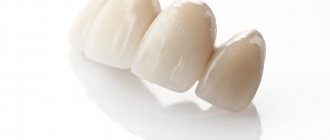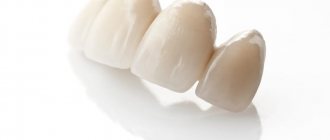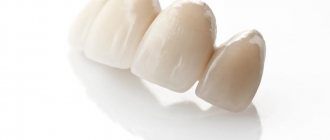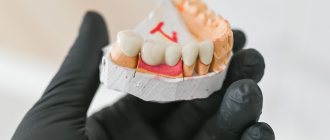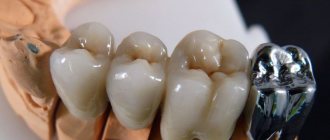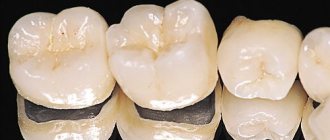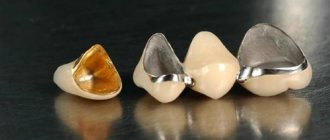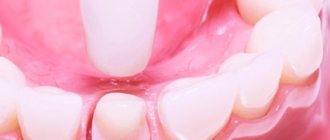What are crowns needed for? This is a very common question that is asked if teeth have made themselves felt. No matter what happens to your teeth, in any, even the most difficult case, you can find a way out. A crown is a lifesaver with which you can save a cracked tooth and restore a broken one, restore a severely worn one (as a result of malocclusion or bruxism) and close a severely deformed or discolored one. It is needed to hold the bridge and cover the implant. The possibilities of a dental crown are not limited to this, and if you have a problem with your teeth, contact us; the specialists of the Zuub dental clinic will always advise and offer options for solving it.
Advantages of metal-ceramic prosthetics
The main advantage of a metal-ceramic crown is that it can be used to obtain a high similarity of an artificial tooth to your own (only metal-free ceramics can give the best result). Metal-ceramic prostheses perform their functions perfectly. Metal-ceramic dental crowns allow you to fully chew food without losing your sense of taste (removable structures can block some of the taste buds).
For patients with a disease such as periodontitis, it is important that microbial plaque practically does not settle on metal ceramics. If the metal-ceramic crown is installed on the tooth correctly, saliva will not get into the space between the crown and the tooth, this reduces the risk of developing caries. However, this does not replace the necessary complete and regular oral hygiene.
Metal-ceramics allows for effective and successful prosthetics in a wide variety of dental situations; in some cases, with the help of orthopedic structures, it is possible to correct even a number of minor defects in the bite. Metal ceramics are recommended in the following cases:
- tooth destruction by more than a third;
- implantation;
- use of bridges;
- on pulpless teeth, because the viability (survivability forecast) of the structure is higher than that of a simple filling.
General overview and features
Conventional crown models are equipped with a metal rim in contact with the gum. The metal element shines through the gum tissue and reduces the aesthetics of the smile. Because of this disadvantage, metal-ceramic prostheses are not used for reconstruction of the frontal zone of the dentition. The shoulder mass (ceramic composition) disguises the rim and eliminates the aesthetic defect.
Installation of a metal-ceramic crown certainly requires a tooth preparation procedure and the formation of a circular ledge. Due to the high strength of the structures, it is recommended to use them for the reconstruction of chewing units.
Metal-ceramic prosthetics technology
Metal-ceramics is a metal crown with a ceramic lining. First, a metal frame is created, onto which ceramic mass is applied in layers and fired. A model is created taking into account all the anatomical details of each tooth, taking into account the load distribution.
Metal-ceramic prosthetics are used when there is a high degree of tooth destruction, when other solutions cannot provide sufficient strength to the structure. With the help of modern technologies, you can obtain any shade of enamel.
Metal-ceramic crowns are not losing ground
The classic and most reliable type of prosthetics is metal-ceramics. Metal-ceramic crowns are a metal base coated with a ceramic material, often called porcelain. Such crowns look quite natural, and thanks to the metal base they are durable, strong and securely fixed, the risk of loosening the metal-ceramic crown is minimized. Chewing functions are restored completely, and the load is distributed as evenly as possible.
Currently, along with metal-ceramic crowns, metal-free crowns based on ceramics or zirconium are often used; they are considered the most modern and effective in terms of tooth restoration. But they have one significant drawback - high cost. That is why metal-ceramic crowns are not losing their positions; they are still popular among clients of dental offices. Specialists of the Zuub.rf clinic network work only with high-quality materials, which is why metal-ceramic crowns will be practically not inferior in quality to more expensive prosthetic options.
As a basis for a metal-ceramic crown, the dentist can, for medical reasons and the client’s wishes, use both base alloys, for example chromium-nickel, titanium, and precious metal alloys: gold, platinum. Of course, alloys of noble metals make metal-ceramic structures expensive, but they also have a number of advantages.
Metal-ceramic crowns based on precious metal alloys are less susceptible to oxidation, and allergic reactions of the body are minimized. Otherwise, metal alloys do not differ in terms of strength and durability.
Metal-ceramics with shoulder mass
The shoulder mass on metal-ceramics is increased when the tooth is ground with a ledge for a crown. The ledge requires special skills from the doctor and is intended to prevent irritation of the ceramic-metal-gum contact zone. If you look closely at the drawing, it is intuitive that turning the tooth with a shoulder is preferable. The cost of both the work and the metal-ceramic crown itself is higher in this case.
The decision about what type of crown to use remains with the patient, but it is worth listening to the doctor’s recommendations.
Indications for the use of metal-ceramic structures
Metal-ceramic structures have a wide range of applications. If you need to restore the chewing part of your teeth, then metal ceramics will be the ideal solution. Since the teeth there are under constant pressure, the metal at the base of the crown will guarantee durability and strength; chips and cracks are excluded. But even this seemingly ideal method of prosthetics has a number of contraindications. Metal-ceramic crowns cannot be used before the age of 16. It is also undesirable to use metal frames when restoring the lower incisors and with such an unpleasant disease as bruxism, and with disorders of the masticatory muscles.
Metal-ceramic crowns based on base metal alloys, for all their advantages, are not without their disadvantages. Such crowns very often stain the gums in a gray tint, this happens when the metal oxidizes. Another common problem is the aesthetics of metal-ceramic crowns. When wearing a crown for a long time, the metal at the base can be easily seen even with the naked eye. Especially in this regard, teeth along the smile line suffer. Metal-ceramics with shoulder mass came to the rescue in solving this problem.
Crowns for front teeth
Crowns for the front teeth have their own characteristics and they are associated precisely with their location in the oral cavity. In addition to strength and reliability, they are expected to be more aesthetically pleasing.
Simply put, people not only bite and partially chew with their front teeth, but also smile. That is, the front teeth are partly responsible for the function of communication and interpersonal communication. And how beautiful the front teeth will look during a conversation and smile depends on the general perception of a person by others.
Two simple and obvious signs of the beauty of the front teeth are as follows:
- the horizontal position should be strictly parallel to the level of the eyes, or rather the line connecting the middle of the pupils;
- The vertical line between the central incisors should run exactly along the middle of the face, the guideline for this is the middle of the nose.
The third sign of aesthetic front crowns is symmetry, which means that the teeth on the left should follow the shape of the teeth on the right and vice versa - they should be similar in shape and size on both sides.
And finally, one more important point - due to the fact that the front teeth have a thin cutting edge, the risk of chipping the ceramic layer from high loads increases. In order to greatly reduce the likelihood of mechanical damage, it is necessary to carefully correct the bite using special articulation paper, similar to ordinary carbon paper.
Is it possible to remove the prosthesis?
Many patients are concerned about the question of whether it is possible to remove a metal-ceramic single prosthesis and how to do it. Installing a crown is a permanent type of prosthetics, but this only means that the patient will not be able to remove it on his own. A dentist can remove a fixed structure, and usually this measure is resorted to when suspicious symptoms of a pathological process occur: an unpleasant odor, penetration of food debris, mobility.
If there is no need to maintain the integrity of the product, it can simply be sawed - this is an old and proven method. Also for this procedure, the “Koppa” apparatus is used - this is a special instrument shaped like a small pistol. With its help, the specialist grinds off the cement at the base, after which he carefully picks up the structure and removes it. Some clinics use ultrasound to destroy the binding properties of cement, but it is not always effective. There is also the Coronaflex device, which is based on the principle of exposure to compressed air - an air flow under high pressure destroys cement without damaging the orthopedic product.
How are they different from other models?
Metal-ceramic crowns differ from all-ceramic single dentures by the presence of a metal frame. This feature makes them not entirely suitable for restoring the smile area - over time, the base will begin to appear, which will negatively affect the aesthetics as a whole. At the same time, products made entirely of ceramics are not suitable for restoration of the chewing area - the material is quite fragile and is susceptible to cracks and chips under intense chewing loads. Therefore, the answer to the question of how these two types of prostheses differ and what is better to install cannot be unambiguous - when choosing one or another option, one must be guided primarily by the location of the defects.
If we compare metal-ceramics with solid metal structures, then the latter are much inferior in aesthetics - they have a silvery color and can be noticeable when smiling, and are suitable exclusively for replacing molars. And in principle, this option has long been a thing of the past - gold crowns were popular in the 90s and were not so much a good option for restoring teeth, but an indicator of the status of their owner.
Complex on 4 OSSTEM implants with delayed loading - from RUB 170,000.
Complex implantation Osstem (South Korea) with delayed loading after 4-6 months.
Guarantee for the doctor’s work - unlimited Call now or order a call
Opening hours: 24 hours a day - seven days a week
There is another option for creating products - from zirconium dioxide material, and today this is one of the best solutions that combines reliability and natural appearance. Compared to metal-ceramics, this material is more durable and at the same time aesthetically pleasing for the restoration of anterior incisors. We will talk in more detail about alternative materials for creating crowns a little later, but for now let’s move on to the indications and restrictions for installation.
Crowns for chewing teeth
The main load when chewing falls on the back teeth. This is associated with increased strength and reliability requirements for crowns on chewing teeth.
Due to the large width and extent of the chewing surface and the correspondingly larger contact area of the upper and lower teeth, a decrease in pressure per unit surface can be assumed.
In simple terms, the risks of chipping the ceramic surface in the crowns in question are not great, and the only special requirement is that there is a certain relief on the contact surfaces of the upper and lower teeth, the so-called cusps, the presence of which ensures effective chewing of food during various lateral movements of the lower jaw.
Stages of prosthesis manufacturing and installation
Dental prosthetics using these structures occurs in several stages.
- Tooth preparation is a therapeutic treatment. First you need to take an x-ray to make sure that there is no inflammation in the upper part of the root. If it is, you will need treatment. In addition, the image will help check how well the root canals are filled. Then you need to understand whether the nerve needs to be removed. Depulping may be necessary on the front teeth or in the presence of an inflammatory process. Chewing teeth can do without this procedure - the dentist will make a decision. After this, you need to treat caries and replace old fillings, and then determine whether it is necessary to install a stump tab under the crown. This is necessary in case of severe tooth decay.
- Prosthetics , which is performed only after treatment. It begins with grinding the teeth for metal ceramics to the thickness of the structure that will be installed. Then an impression is taken from the stump, from which a crown is created in the laboratory in 1-2 weeks. All this time, the patient wears temporary crowns made of plastic, which protect the prepared stump and give the smile an aesthetic appearance. After the permanent crowns are made, they are installed with temporary cement, and then with permanent cement.
- Preventive examination , for which you need to regularly visit a doctor once every six months.
Sometimes it becomes necessary to remove the crown if the metal-ceramic tooth falls out or the enamel breaks off. This is quite difficult to do; most often the prosthesis is sawed and then removed. In this case, the prosthesis cannot be restored, and a new one will have to be made. If this option is not for you, you can remove the prosthesis using ultrasound, which has a destructive effect on the cement.
Indications and contraindications
Metal-ceramic crowns are used for:
- Restoring the shape, function and color of teeth damaged by caries, trauma, fluorosis, taking medications, etc.
- Increased abrasion of enamel;
- Correction of dental anomalies that cannot be straightened using orthodontic methods;
- Elimination of both single dental defects and 2-3 adjacent teeth;
- Supports for removable dentures.
The installation of metal-ceramics is excluded in case of defects in the crown of the abutment tooth (if it is thin-walled, low, etc.), severe form of periodontitis, with large defects in the row (if more than 4 teeth are missing), if the tooth has living pulp.
Differences
The main difference between a prosthesis with a shoulder mass and a conventional design lies in the design features. A layer of ceramic is laid along the lower base of the crown along the line of contact with the gum tissue. The unit is turned to form a rounded shoulder. This ensures precise fitting and a close-to-natural appearance.
Manufacturing and installation stages
In preparation for implantation, the patient undergoes a thorough diagnosis and clinical examination of the oral cavity, and undergoes general tests. The doctor interviews the patient for complaints and concomitant diseases in order to identify indications and contraindications for dental treatment.
The prosthetic structure is manufactured in a dental laboratory in several stages:
- The edges of the cast metal frame are shortened by 0.5-0.8 mm. The prosthesis is treated with aluminum oxide, primed and fired.
- The boundary of the preparation of the ledge for the prosthesis is determined. The surface is fixed with varnish.
- The cervical area is covered with a ceramic composition.
- The crown is dried and fired. The technician reapplies the ceramic layer. The procedure is repeated.
- The prosthesis is installed on the tooth and covered with a dentin and transparent layer. The glazing procedure is carried out.
The adaptation process can take from 14 days to a couple of months. During this period, the patient must listen sensitively to his body. If discomfort or pain occurs, you should definitely contact your dentist.
Care
To maintain the aesthetics and functionality of the crown, it is necessary to follow the rules of care. Daily hygiene of the product is identical to standard tooth brushing. After each meal, it is recommended to rinse your mouth to remove food debris and prevent plaque buildup.
It is recommended to use floss on an ongoing basis to work out the interdental spaces. The use of an irrigator will ensure a hygienic result.
Price
The price of metal-ceramic crowns with shoulder mass is practically no different from the cost of traditional metal-ceramic products. Pricing depends on the scope of work, the need to use additional structures and related procedures. On average, the price of a product with shoulder mass is from 9,400 rubles. The exact cost is calculated by the doctor. The dentist examines you, advises you, draws up a preliminary treatment plan and announces the price of the service.
Cost of metal-ceramic crowns in Moscow
| Name | Price from |
| Consultation with an orthodontist (included in the manufacturing cost when ordering a crown) | 500 rub. |
| Cost of a metal-ceramic crown | 10,000 rub. |
Denta Labor dental laboratory produces metal-ceramic crowns. You can find out prices for these designs by calling: +7 . We are one of the best clinics in Moscow and offer high quality services. We employ only professionals who are masters of their craft. We work on the most modern equipment, using innovative techniques and high-quality materials. Do you want to get your dazzling smile back? Then call and make an appointment.
How long does it take to create one crown?
Many patients are concerned about how long it takes to make metal-ceramic structures. The process of creating one such crown usually takes about 10-14 days. How much a product is made is also influenced by the workload of doctors, namely dental technicians. Good specialists rarely sit idle, so if you are offered such treatment quickly and at a low price, it is better to be wary. In this matter, it is very important to selectively approach the search for a clinic and a doctor, since the quality and durability of the result will largely depend on the experience and skill of the specialist.
Service life and guarantees
The service life of conventional metal-ceramics is about 12 years, and those based on precious metals – 15 years. To extend the service life, you need to discuss in advance with your doctor how to care for and what to brush your teeth with now. In most cases, it is enough to provide proper oral care as a whole.
Many are also interested in the question of where to repair a crown if a piece of ceramic breaks off from it. In such a situation, each individual situation must be considered individually. So, if a fragment remains, you can take it with you to the dentist so that he can try to reattach it. Another option is to completely replace the structure with a new one - this is the most reliable, but at the same time expensive way. It is also possible to remove the prosthesis for repair, but usually such products are securely attached to cement, so the structure can be seriously damaged during removal.
In some cases, it is possible to carry out restoration using the direct method, that is, directly in the patient’s mouth. In such a situation, the damaged area is subjected to special treatment, grinding and drying, covered with a binder, after which the composite material is applied layer by layer and illuminated with a UV lamp. It should be noted right away that it is unlikely that the former reliability will be achieved, and the repaired area may stand out in color, which will inevitably affect the appearance of the artificial tooth.
Helpful advice! To protect yourself from additional expenses for repairs and re-prosthetics, be sure to take control X-rays before the end of the warranty period, even if no symptoms bother you.
It is better to take a photo and undergo a consultation at another clinic, despite the fact that you will have to pay for it. This will be a good safety net that will help protect yourself from much more significant expenses for complete retreatment if you suddenly encounter complications immediately after the end of the warranty.
